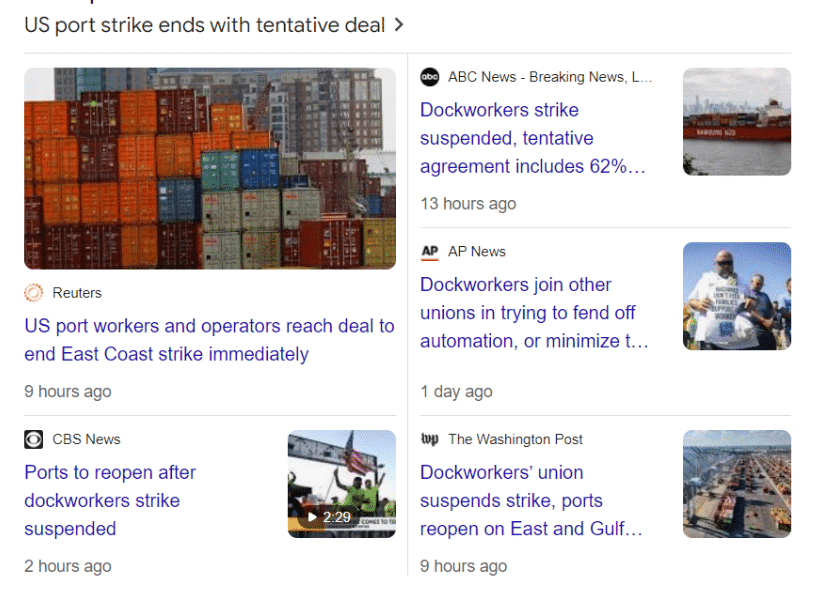Every business relies on a smooth supply chain. But what happens when dockworkers walk off the job? While dockworker strikes may seem like someone else’s problem— until your shipment is in a standstill for weeks or months on end.
Manufacturers that rely on global supply chains must ask three questions:
- How exposed are we to this risk?
- What are we going to do about it?
- What’s our contingency plans?
The Latest US Dockworker Strike in 2024
- Strikes affecting 36 US ports, causing huge backlogs and anchored ships
- Tentative deal includes a 62% wage hikes over 6 years (various sources)

A Brief Look at Dockworker Strikes in North America
Dockworker strikes are a recurrent theme across North American ports. They are happening more frequently too.
- 2023 – Canadian West Coast Ports (British Columbia): In July 2023, dockworkers on Canada’s West Coast went on strike, paralyzing key ports in British Columbia, including Vancouver and Prince Rupert. This 13-day strike disrupted more than $11 billion in trade and significantly impacted supply chains. While the strike ended, it took weeks for operations to return to normal.
- 2022 – West Coast U.S. Ports (California): The International Longshore and Warehouse Union (ILWU) initiated a labor dispute affecting 29 ports along the West Coast, including Los Angeles and Long Beach. These ports handle over 40% of U.S. imports, causing significant delays. Negotiations between the ILWU and the Pacific Maritime Association (PMA) took over a year to resolve, impacting supply chains across multiple industries.
- 2019 – Port of Montreal (Canada): A strike involving dockworkers and the Maritime Employers Association (MEA) lasted 10 days, but took months of negotiations to finalize a collective agreement. Montreal is one of Canada’s largest ports, handling cargo for the eastern part of the country and the U.S. Midwest. The impact of the strike was felt by all manufacturers and distributors alike.
- 2018 – Port of Charleston (South Carolina): A 3-day strike in Charleston caused brief disruptions, but many businesses had to pay for costly contingency plans, such as rerouting goods or using expedited air freight to meet deadlines.
- 2016 – Port of New York and New Jersey: This unexpected strike was short-lived, lasting just a few days, but it demonstrated the fragility of supply chains even when disruptions are brief. Many ships were diverted to other ports, causing delays and increasing costs for businesses that rely on these critical ports.
- 2014-2015 – U.S. West Coast Ports: Another ILWU dispute, this time causing severe port congestion and slowdowns that led to an 8-month negotiation. The protracted conflict led to perishable goods rotting at ports and forced businesses to scramble for alternatives, whether by air freight or rerouting shipments through Gulf or East Coast ports.
The True Cost of Disruptions
When dockworkers strike, manufacturers, distributors, and consumers all feel the consequences. Delays in materials lead to production slowdowns, increased operational costs, and perhaps worst of all; order cancellations.
Businesses that rely on steady imports of sheet metal products can experience costly downtime and revenue loss. For companies working with OEMs, this can jeopardize client relationships; ultimately harming your bottom line.
When these strikes occur at critical junctures—like the peak holiday season or just before a new product product—the damage can be even more severe and costly!
Derisk Your Supply Chain
One of the best ways to derisk is by partnering with local suppliers. This is a hedge of protection against disruptions caused by port strikes or other geopolitical events. Local partners allow for better lead times and control over your supply chain and production needs.
Local suppliers allow for:
- Faster lead times: Without the need for overseas shipping, your components arrive faster. Local manufacturers can often offer quicker turnaround times, especially if they’re based nearby or within your same region. This is critical for industries that require just-in-time production.
- Streamlined operations: Local fabricators don’t face the same vulnerabilities to global supply chain issues, including dockworker strikes, natural disasters in distant countries, geopolitical events that can cause halted shipments. With a domestic partner, your operations are less likely to be disrupted.
- Flexible production: If your production needs change, it’s easier to coordinate with a local fabricator to make adjustments on the fly. The other option is to wait longer with overseas manufacturers bound by longer shipping times, custom processes, and import duties.
- Lower freight costs (no tariffs for USMCA countries): Shipping large volumes of sheet metal parts from overseas is expensive. By working with local suppliers, you save on product tariffs and freight costs.
- Better communication: Time zone differences, language barriers, and limited access to your overseas partners can make communication difficult. Local fabricators offer easier access, fostering better collaboration and ensuring that your quality standards are met.
- Higher quality control: Domestic suppliers offer tighter quality control measures and faster responses to any issues that arise. It’s easier to visit a local production facility and monitor progress than coordinate overseas.
Conclusion
Recent dockworker strikes are a stark reminder of the risks and the issue with over-reliance on global supply chains. For industries requiring a large amount of sheet metal products, dockworker strikes can have a huge impact; leading to delays, lost revenue, and strained client relationships.
By partnering with local fabricators, you mitigate all these risks. Make sure to have a domestic plan in place. For further consideration on supply chain issues, and how to best select a reliable supplier, read this article.



